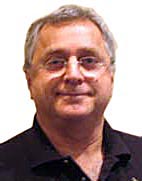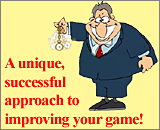 |
Backgammon Tips
 |
|
|
|
Ten Backgammon Lessons
| |
by Phil Simborg, 2006
|
|

|

|
In my 45 years of playing backgammon, I have been fortunate to have been given backgammon lessons and tips from some of the best players who ever lived. Here are the 10 best lessons, summarized for you.
- Oswald Jacoby. In 1967, just out of college, I was a top bridge player (life master). I found myself playing often, in Dallas, against one of the greatest bridge and backgammon players that ever lived, Oswald Jacoby. Oswald taught me a lot, but the lesson that stands out the most is this: Backgammon is always a race. The winner is the first one to get all his checkers off first. Even if you win with the cube, it's because your opponent decided you were too likely to get your checkers off first. And since it's always a race, you should always be aware of the pip count.
- Kit Woolsey. When internet backgammon first started, there was only one place to play, on FIBS. And the best player there was Kit Woolsey. To this day, he is still one of the best teachers and players in the game. The first lessons I ever paid for were from Kit. I paid him $75 an hour for on-line lessons. I still use Woolsey's Law of doubling to this day. Here's how it works.
If you are thinking about doubling, first put yourself in your opponent's position and ask yourself if you are sure whether it is a take or drop. If you are sure it is a take, then it might not be a double. If you are sure it is a drop, then you know you have a good double, unless you are too good to double (too many gammons). But what if you are not sure whether it is right to take or drop? What if it's on the edge? Then for sure, it is a double. For one thing, if you're not sure, your opponent might not be sure either. If you double, you give him the chance to make a mistake and do the wrong thing. And even it is really is right on the edge, and it's a tossup whether he should take or drop, you are still better off doubling than not doubling in that situation.
- Joe Sylvester. One of the all-time greats lived with me in Chicago for several months. I didn't charge him rent, but I did make him teach me the game. Joe's mind is so advanced, so mathematical, that I often couldn't follow him. One day I got angry and asked him to summarize the strategy of the game in simple, layman's terms. And he did. He said, when it comes to checker play, you generally should look at three things, and generally in this order: Can you hit? Can you make a point? Can you safety a checker? And when it comes to doubling or taking a double, again, consider these three things: race; opportunity; threats.
- Neil Kazaross. I often played Neil in live tournaments, and he was always most generous with his help and advice. Once I asked him about a double I took that turned out to be a terrible decision. Instead of just giving me the answer, he asked me what my take point was at the particular match score. I had no clue. Neil went on to explain that in order to know whether or not to take a cube, you needed to first estimate your odds of winning vs. losing and odds of gammons, and see if that is more or less than your take point. And to calculate your take point, you simply must memorize the match equity tables. Since Neil supplied the match equity tables to Snowie and other software, he was clearly an expert. Neil taught me that if I want to play with the big boys, I needed to study more and learn about match equities.
- Perry Gartner. One day, after playing with Perry, one of the top players in the game and a true perfectionist and student of the game, we were discussing a double. I was proud to explain my take, pointing out that it was well within my takepoint. But then Perry asked me if I had considered the price of gammons. I drew a blank. The point is, sometimes gammons don't mean a thing, and sometimes they could win you or cost you the match. So when you are estimating your odds of winning or losing a game, you must also factor in the price of a gammon, for and against you, to truly see the whole picture.
- Jake Jacobs. Over the years, Jake has probably taught me more and insulted me more than anyone I know. But his insults are so intelligent and fun, and he was usually right, so I never got made at him. One thing Jake convinced me that has been a great lesson, is do not play down to your opponent. If you are playing someone who plays poorly, or takes cubes when they shouldn't, etc., generally speaking, you are best off making what is mathematically and statistically the right plays and decisions instead of adjusting your game too much based on the opponent's style. For example, even a player who takes cubes late in the game when they shouldn't can also make the mistake of dropping a cube they should take—so double when you should double.
- Nack Ballard. After a while I graduated from FIBS and started playing where most of the best players in the world played: Gamesgrid. I soon found that the best player there, and the best player in the world according to most people, was Nack Ballard. I really wanted to play him, but he would only play for money. So I did, and I got killed. Out of pity, Nack made me a deal. We played 3 point matches for $100 a match, but at the end of every game he would give me advice and help about anything I did wrong. I paid well for my lessons, but I learned a lot. The best lesson I learned from Nack is: Make the five-point. Almost any time you can, almost regardless of the other choices, making the five-point is right. Back when he was teaching me this, the computer programs did not agree. Now, they have gotten better and they agree with Nack.
- David Wells. I played for money and for fun many hours with David, and he's a great backgammon player and teacher. When David explained a move, it sounded far different from when Sly (Joe Sylvester) or Jake explained a move. Dave was far more visual. Instead of giving me mathematical reasons for his move, he generally gave me visual, descriptive explanations. He didn't want his inner board to look like swiss cheese he often said, meaning he didn't want to make points that were separated, like the 6, 4, and 2. He wanted to make them in order. He wanted to play what is called pure backgammon, where you try to make blocks of points, primes, and keep your checkers together. I've always kept this visualization in mind.
- Mary Franks. One of the best lady players in the game, Mary taught me something you don't find in the books. She taught me money management. No matter what the odds say, if you are playing for money, and you're looking at a 16 cube that is supposed to be taken, but there are very strong gammon risks, find a way to negotiate your way out of this, or drop the cube. Don't worry if people tell you later it was a take. Most of those people are broke taking big cubes they should have taken.
- Abbas Zaltash, Yamin Yamin, Laila Leonhart, Steve Mellen, Steve Sax, Malcolm Davis, Falafel, Peter Thompsen, David Wells, Frank Talbot, Mike Corbett and many, many others taught me the most important lesson of all. If you sit down to play against people who are clearly better than you are, be prepared to lose. The key to winning in backgammon, as in most every competition, is try to play people who are worse than you!
|
|

Return to:
Backgammon Galore
|
|
|
|

